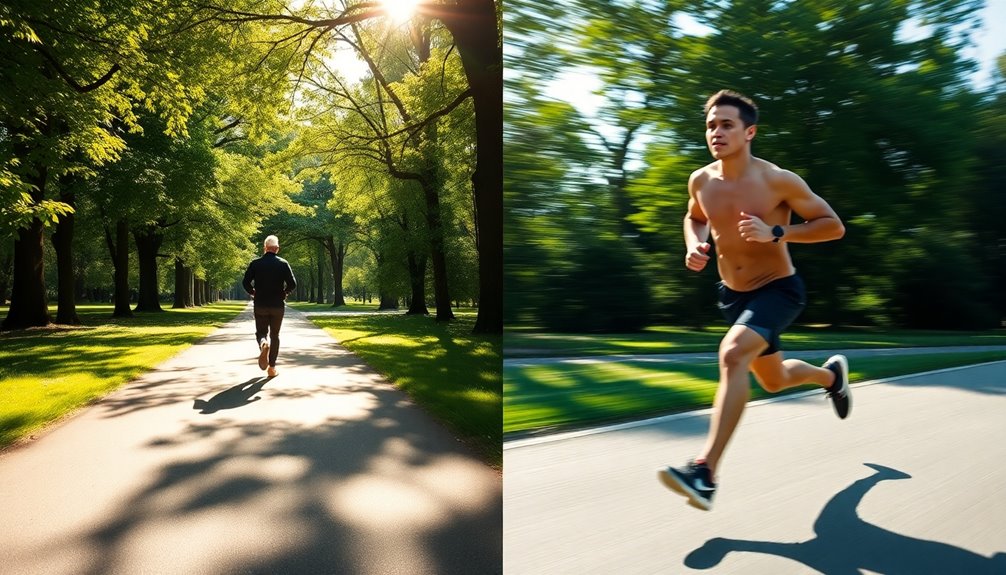Walking and running each have unique perks that align with different fitness goals. If you're looking for a low-impact option to boost your heart health and manage stress, walking is perfect. It's accessible, easy on your joints, and a great way to enhance your mood. On the other hand, if you want to burn calories quickly and improve endurance, running is your best bet. It ramps up your heart rate and targets muscle strength. Ultimately, it depends on what you enjoy most and what fits your lifestyle. Keep going, and you'll discover even more insights to shape your fitness journey.
Key Takeaways
- Walking is low-impact and suitable for beginners, making it ideal for those with joint concerns or new to exercise.
- Running burns more calories in a shorter time, making it efficient for weight loss and cardiovascular endurance.
- Both activities improve mood and reduce stress, but running may offer a more significant boost in mental health benefits.
- Walking is a sustainable option for long-term fitness, while running requires proper technique and gear to prevent injuries.
- Your personal fitness goals, preferences, and physical condition should guide the choice between walking or running.
Health Benefits of Walking
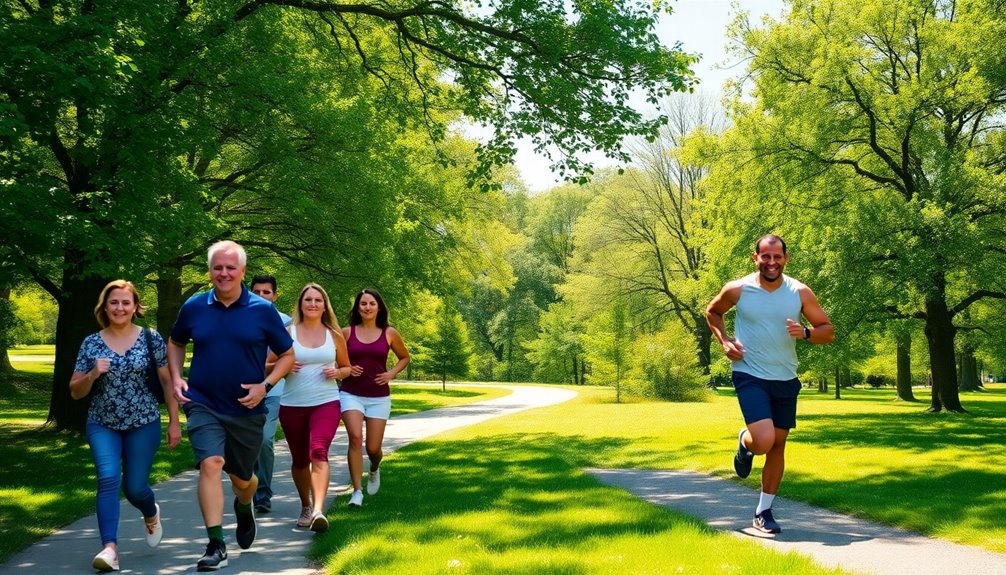
While you might think running is the go-to exercise for fitness, walking offers an impressive array of health benefits that can greatly enhance your well-being. It's accessible, low-impact, and can be easily incorporated into your daily routine. You don't need fancy equipment or a gym membership to enjoy the advantages of walking. Just lace up your shoes and step outside!
One of the most significant benefits of walking is its cardiovascular advantages. Regular walks can strengthen your heart, improve circulation, and lower blood pressure. When you engage in brisk walking, your heart works more efficiently, reducing the risk of heart disease. Plus, it's a fantastic way to boost your mood and mental health. You'll feel energized and connected to your surroundings, especially when walking with friends or family.
In addition to these cardiovascular benefits, walking plays a critical role in weight management. It's an effective way to burn calories and maintain a healthy weight. Whether you're aiming to shed a few pounds or simply want to keep your weight in check, incorporating walking into your routine can make a significant difference. You can easily adjust your pace and distance to suit your goals, making it a flexible option for everyone. Moreover, combining walking with a comprehensive program like Adaptive Body Boost can further enhance your fitness journey.
Health Benefits of Running

If you're looking to enhance your fitness routine, running offers a dynamic set of health benefits that can take your well-being to new heights. Not only does it boost your cardiovascular endurance, but it also plays a pivotal role in weight management. Incorporating running into your lifestyle can transform both your physical and mental health while fostering a sense of community among fellow runners. Additionally, strong glutes can improve your running efficiency and overall performance.
Here's a quick overview of the key health benefits of running:
| Health Benefit | Description |
|---|---|
| Improved Cardiovascular Endurance | Running strengthens your heart and lungs, improving blood circulation and oxygen intake. |
| Effective Weight Management | It's a high-calorie burning exercise that helps you maintain a healthy weight or lose excess pounds. |
| Enhanced Mood | Running releases endorphins, which can uplift your mood and reduce stress levels. |
| Stronger Muscles and Bones | It builds muscle strength and improves bone density, helping to prevent injuries.
Caloric Burn Comparison

When it comes to caloric burn, the choice between walking and running can significantly impact your fitness journey. Understanding how each activity affects your body can help you make an informed decision that aligns with your goals. Generally, running burns more calories than walking, primarily due to its higher exercise intensity. When you run, your heart rate increases, and your metabolic rate spikes, indicating that you're burning energy at a faster pace.
For example, a person weighing 155 pounds can burn approximately 295 calories in 30 minutes of running at a moderate pace, while walking at a brisk pace for the same duration might only burn around 150 calories. That's a notable difference that can accumulate over time! However, it's crucial to remember that both activities have their place in a well-rounded fitness routine. Incorporating mini band workouts can enhance muscle tone and fat elimination, complementing your walking or running regimen.
If you're just starting out or looking for a low-impact option, walking can still provide a solid workout and help you build endurance. It can also be a great way to connect with friends or enjoy the outdoors without the strain that running sometimes brings.
Ultimately, the best choice for you depends on your personal fitness goals, preferences, and any physical limitations you might have. Whether you choose to walk or run, what matters most is staying active and enjoying the journey. So lace up those shoes, find what feels right for you, and keep moving toward your fitness goals!
Impact on Joint Health
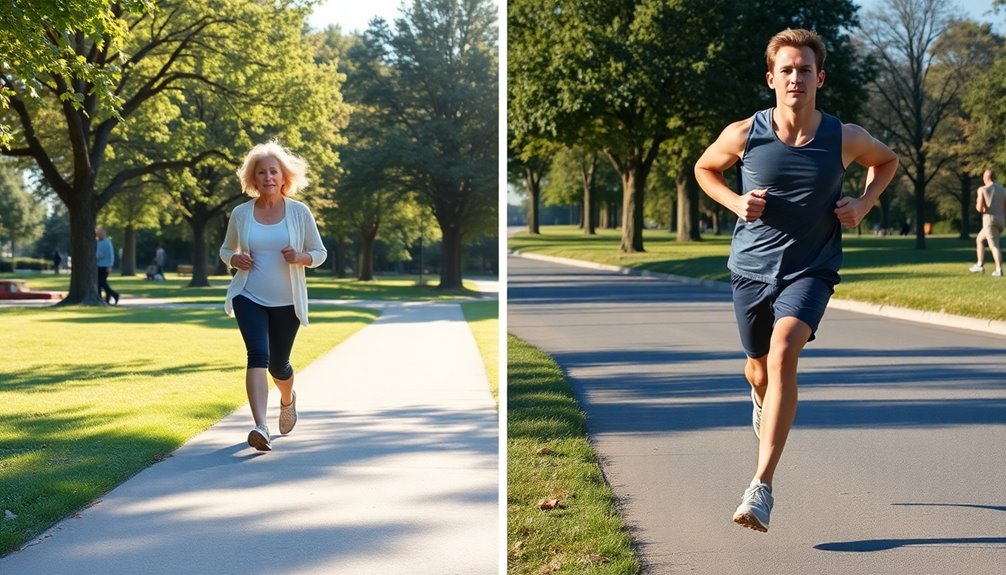
The choice between walking and running also plays a significant role in your joint health. It's crucial to examine how each activity impacts your body, especially your joints. While both walking and running can contribute to overall fitness, they've varying effects on joint health. Here are some key points to bear in mind:
- Walking is a low-impact exercise, which helps alleviate stress on your joints.
- Running can heighten the risk of injury if proper form and appropriate shoes aren't used.
- Both activities can enhance joint health advantages by strengthening the surrounding muscles.
- Regular movement, whether walking or running, fosters enhanced flexibility and mobility.
Walking is generally gentler on your joints, making it a superb choice for those concerned about injury prevention. It's a secure way to remain active, and it can be sustained for longer periods without causing strain. Moreover, incorporating a simple 10-second ritual can help improve your stability and balance, further protecting your joints from potential injuries.
On the other hand, running provides cardiovascular benefits but may result in joint issues if you're not cautious.
If you're seeking a way to engage with a community, contemplate joining a walking or running group. You'll not only enhance your joint health but also experience a sense of belonging as you connect with others who've similar goals. Ultimately, choose the activity that resonates with you, keeping in mind the significance of joint health benefits and injury prevention. Your body will express gratitude for it!
Time Commitment and Efficiency
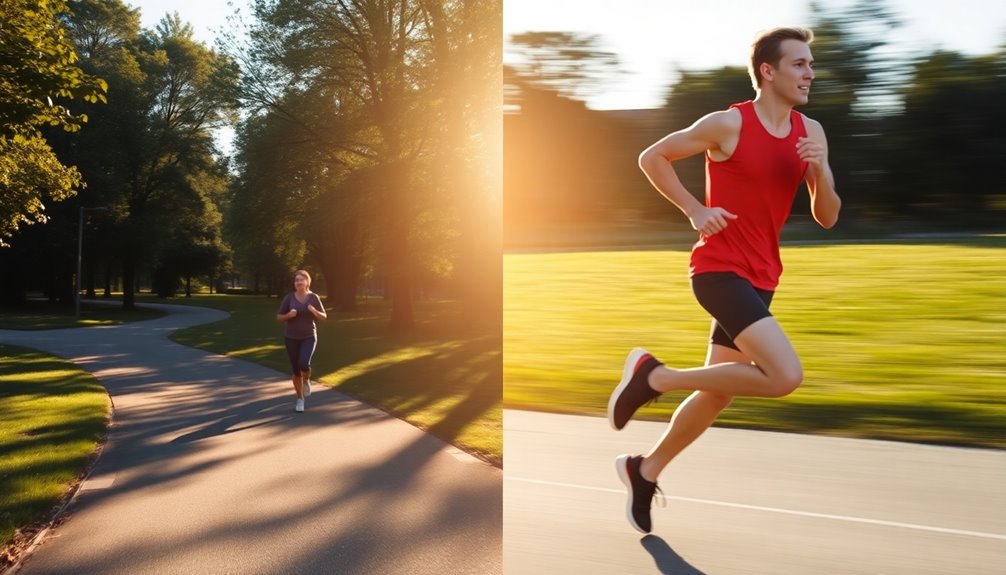
Balancing a busy schedule can make it challenging to find time for exercise, but understanding the time commitment and efficiency of walking compared to running can help you maximize your efforts. Both activities can be effective, but they differ significantly in pace comparison and energy expenditure.
When considering your goals, think about the training intensity and workout duration each option requires. Running typically demands a higher intensity, meaning you can achieve more in a shorter time frame. However, walking offers a more sustainable, lower-intensity workout that can seamlessly fit into your daily routine. Additionally, engaging in regular physical activity, such as walking or running, can significantly contribute to reversing Type 2 diabetes and improving overall health.
Here's a simple comparison to help you visualize the distinctions:
| Activity | Average Workout Duration (30 mins) | Estimated Calories Burned |
|---|---|---|
| Walking | Moderate Pace (3-4 mph) | 120-200 |
| Running | Fast Pace (6 mph) | 300-450 |
| Walking | Brisk Pace (4-5 mph) | 180-300 |
| Running | Sprint Pace (8 mph) | 450-600 |
| Walking | Casual Pace (2-3 mph) | 80-120 |
Ultimately, whether you choose walking or running, what matters is finding an activity that you enjoy and can stick with. By making informed decisions about your time commitment and efficiency, you'll not only stay active but also nurture a sense of belonging within your fitness community.
Mental Health Benefits
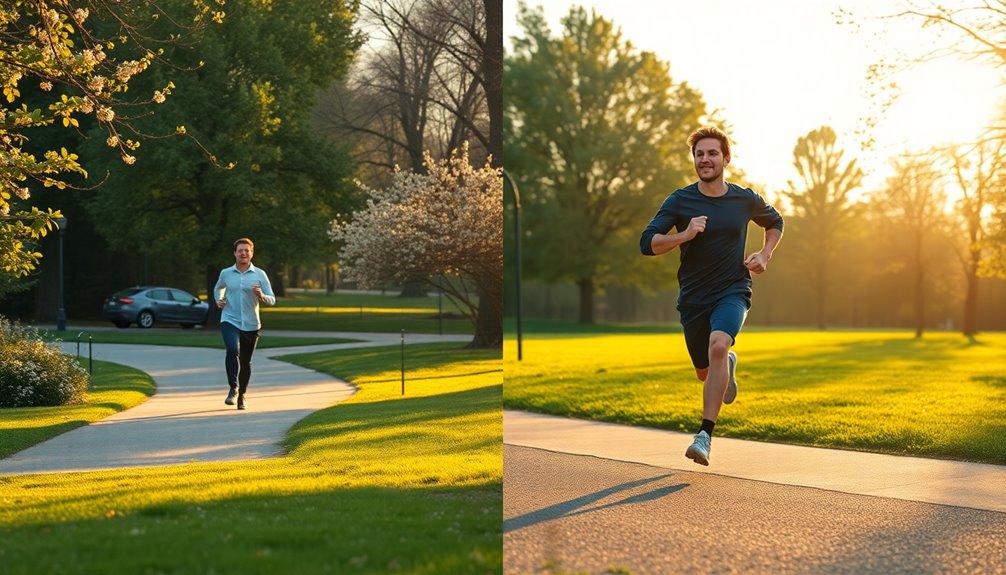
Both walking and running offer significant mental health benefits that can enhance your overall well-being. Engaging in either activity can provide you with the tools to manage stress and improve your mood, making it easier to navigate life's ups and downs.
Here are some key benefits you might enjoy:
- Stress Relief: Both activities act as natural stress-busters, helping you clear your mind and find peace.
- Mood Enhancement: Regular physical activity releases endorphins, those feel-good hormones that can elevate your mood and give you a sense of happiness.
- Improved Sleep: Walking or running can promote better sleep patterns, allowing you to recharge and face the day with renewed energy.
- Social Connection: Whether you join a running group or walk with friends, these activities foster connections, helping you feel supported and understood.
Incorporating walking or running into your routine isn't just about physical health; it's a powerful way to nurture your mental state. When you step outside and engage in these activities, you're not only getting a workout but also taking a proactive approach to your mental well-being.
You may find that the rhythmic motion of your feet calms your thoughts, giving you the clarity to tackle challenges. So, lace up those shoes and take a step towards a happier, healthier you. Whether you choose to walk or run, you're investing in yourself and your mental health.
Suitability for Different Fitness Levels
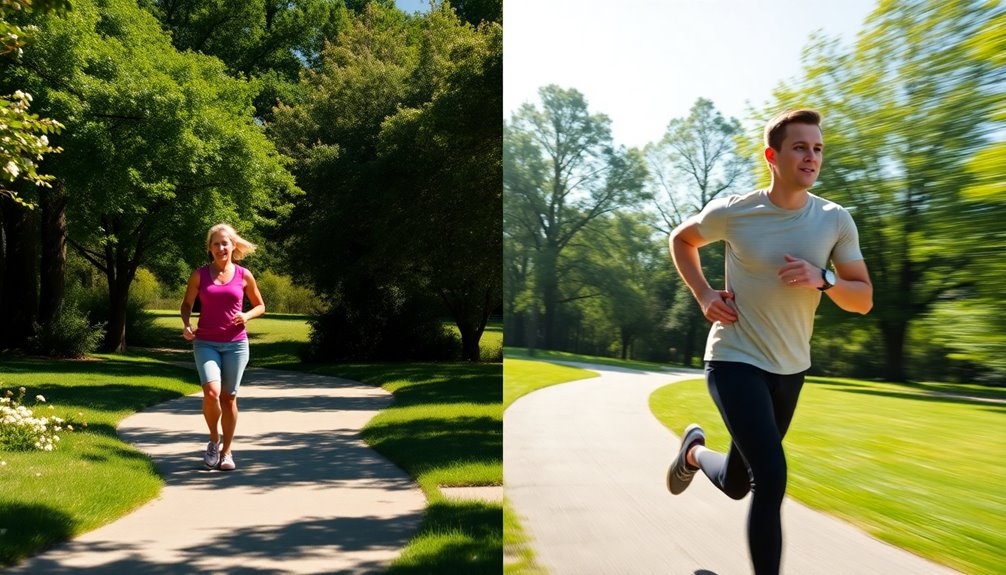
Whether you're just starting your fitness journey or looking to elevate your routine, walking and running can seamlessly integrate into your lifestyle. Both activities offer unique benefits and can cater to various fitness levels, making them accessible for everyone.
If you're a beginner, walking is a fantastic choice. It's a low-impact exercise that allows you to ease into physical activity without overwhelming your body. You can start with short, leisurely walks and gradually increase your distance and pace as your fitness improves. These beginner-friendly options make walking a great way to build endurance and confidence.
On the other hand, if you've already got some fitness experience under your belt, running might be your next step. It offers a higher intensity level that can help you burn more calories and improve cardiovascular health more quickly. However, it's crucial to listen to your body and establish a solid foundation before diving into running. Engaging in regular physical activity can also help manage high blood pressure and promote overall well-being.
You might consider incorporating interval training, alternating between walking and running, to ease into it while minimizing the risk of injury.
Both walking and running can be adjusted to match your intensity levels and personal goals. The key is to find what feels right for you. Remember, it's not about how fast you go or how far you run; it's about moving your body and enjoying the journey. Embrace whichever activity resonates with you, and you'll be well on your way to achieving your fitness goals.
Social Aspects of Each Activity
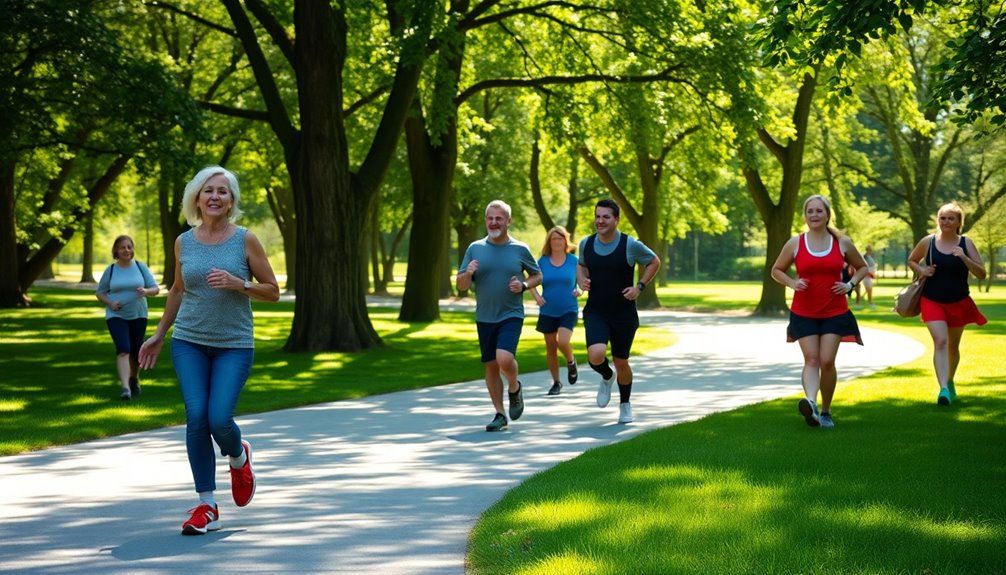
As you explore walking and running, consider the social benefits each activity brings to your life. Engaging in these exercises can enhance your sense of community, forge new friendships, and offer motivation sources that propel you toward your fitness goals. Here's how each activity can enrich your social life:
- Walking Clubs: Join a local walking group and enjoy leisurely strolls while chatting with fellow enthusiasts.
- Running Events: Participate in races or fun runs that foster camaraderie among runners of all levels.
- Group Dynamics: Both activities thrive on shared experiences, creating bonds and support systems that encourage consistency.
- Social Media Communities: Connect with like-minded individuals online, sharing your journeys and celebrating milestones together.
Walking tends to invite a more relaxed atmosphere, where you can engage in conversation and take in your surroundings. This makes it easier to form friendships based on shared interests.
On the other hand, running often taps into a competitive spirit, pushing you to achieve personal bests while building connections with others who share that drive.
Both activities serve as motivation sources, whether you're enjoying a scenic walk with friends or training for a marathon with a running buddy. Ultimately, the social aspects of walking and running can foster a sense of belonging, making your fitness journey not just about individual goals but also about the relationships you cultivate along the way. Additionally, honing your skills through activities like hand sharpening can lead to a greater sense of accomplishment that you can share with your fitness community.
Gear and Equipment Considerations
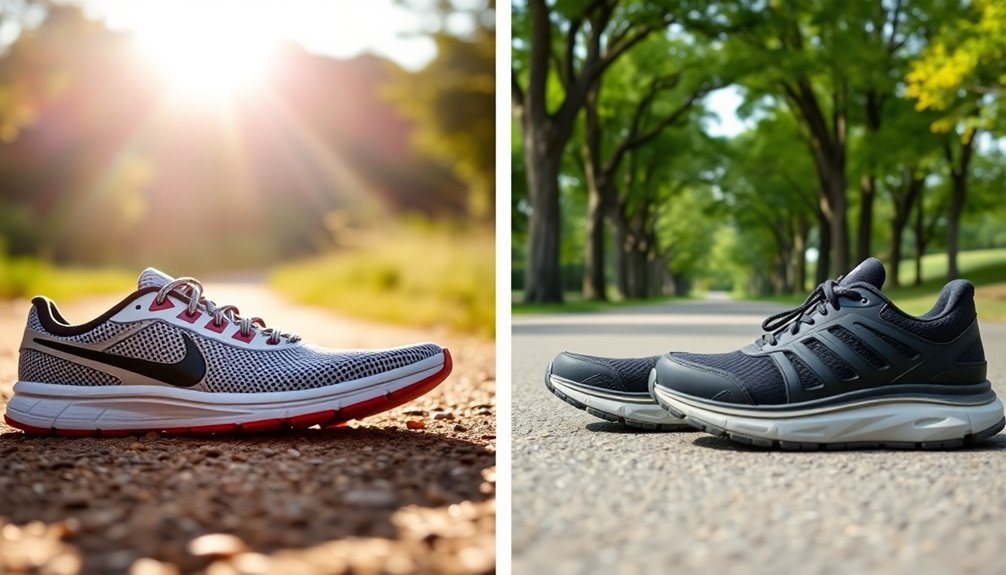
When it comes to gear and equipment, choosing the correct essentials can greatly enhance your walking or running experience. Whether you're hitting the pavement for a brisk walk or a vigorous run, the appropriate gear can make all the difference.
Shoe selection is crucial for both activities. Well-fitted shoes help prevent injuries and provide the support you need. Look for shoes that cater to your specific activity—walking shoes offer cushioning for a softer stride, while running shoes provide stability and responsiveness.
Clothing options also play a significant role. Breathable, moisture-wicking fabrics keep you comfortable and dry, allowing you to focus on your workout. Layering can be effective for varying weather conditions, so consider lightweight jackets or vests that you can easily remove if needed.
Here's a quick reference table to help you choose your gear:
| Gear Type | Walking | Running |
|---|---|---|
| Shoe Selection | Cushioned, supportive | Lightweight, responsive |
| Clothing Options | Loose-fitting, breathable | Form-fitting, moisture-wicking |
| Accessories | Simple, minimal (e.g., hat, water) | Tech gadgets (e.g., GPS watch) |
| Weather Gear | Light jacket, umbrella | Windbreaker, thermal layers |
Investing in the right gear not only enhances your performance but also fosters a sense of belonging in the community, as you share your passion with others. Additionally, staying hydrated with SlimCrystal bottles can significantly boost your energy levels during workouts. So gear up, and let's hit the ground running—or walking!
Personal Goals and Preferences

Choosing the right gear lays the foundation for pursuing your fitness journey, but personal goals and preferences ultimately shape your experience. Understanding what drives you can make all the difference in your motivation and commitment. Whether you're looking to shed a few pounds, boost your endurance, or simply enjoy the outdoors, aligning your fitness routine with your lifestyle and schedule is vital.
Consider these factors when setting your fitness goals:
- Time Commitment: How much time can you realistically dedicate to walking or running?
- Fitness Objectives: Are you aiming for weight loss, improved cardiovascular health, or just stress relief?
- Enjoyment Factor: Which activity do you find more enjoyable—walking or running?
- Social Engagement: Do you prefer solo workouts, or do you thrive in group settings?
Your goals will guide your choice. If you're pressed for time, a brisk walk might fit your schedule better. On the other hand, if you're seeking a more intense workout, running could be your go-to. Remember, goal setting isn't just about numbers; it's about creating a sustainable routine that fits into your lifestyle. Incorporating mindfulness meditation into your routine can further enhance your focus and commitment.
Ultimately, it's about finding what resonates with you. Whether you opt for walking or running, choose the path that excites you, keeps you motivated, and builds a sense of community. Your journey is unique, and embracing that will make each step more rewarding.
Frequently Asked Questions
How Do Weather Conditions Affect Walking and Running Performance?
Weather conditions can greatly impact your performance, whether you're walking or running. When it's hot, you need to pay extra attention to your hydration levels—stay hydrated to avoid fatigue. In colder weather, your clothing choices matter; layering up can keep you warm and comfortable. Remember, adapting to the elements not only enhances your performance but also makes your experience more enjoyable, helping you feel part of the active community.
Can Walking or Running Help With Weight Loss Plateau?
If you're facing a weight loss plateau, both walking and running can help reignite your progress. Walking burns calories and is great for muscle toning, while running offers a metabolism boost that can enhance your endurance training. By mixing up your routine with both activities, you'll keep your body guessing and engaged.
What Are the Best Times of Day to Walk or Run?
The sun rising or setting can be the perfect backdrop for your walks and runs. Morning walks energize you for the day ahead, while evening runs provide a great way to unwind. If you prefer the treadmill, you've got control over your environment, but outdoor sessions connect you with nature.
Choose what fits your schedule and vibe, and remember, every step you take brings you closer to your fitness goals. You've got this!
Is It Safe to Walk or Run During Pregnancy?
Yes, it's generally safe to walk or run during pregnancy, but you should always consult your healthcare provider first. Prenatal fitness is essential for maintaining maternal health and can help you feel energized. Listen to your body and adjust your routine as needed.
Staying active can foster a sense of community among other expectant mothers, making your journey even more rewarding. Remember, every step you take is a step toward a healthier pregnancy!
How Do Walking and Running Impact Sleep Quality Differently?
Walking and running affect sleep quality in unique ways. Higher exercise intensity, like running, can boost your overall sleep quality but may also leave you wired if done too close to bedtime.
On the other hand, walking tends to promote relaxation and isn't as demanding, making it easier for you to wind down. Consider your duration; longer walks can still yield great benefits, so find what fits your routine and watch your sleep improve!
Conclusion
Ultimately, whether you lace up your sneakers for a brisk walk or a spirited run, both activities offer unique perks that cater to your goals. Walking's gentle embrace is perfect for those easing into fitness, while running can ignite your passion for intensity. So, choose the path that sparks joy for you, and remember, it's not just about speed or distance—it's about enjoying the journey and celebrating every step you take toward a healthier you!

